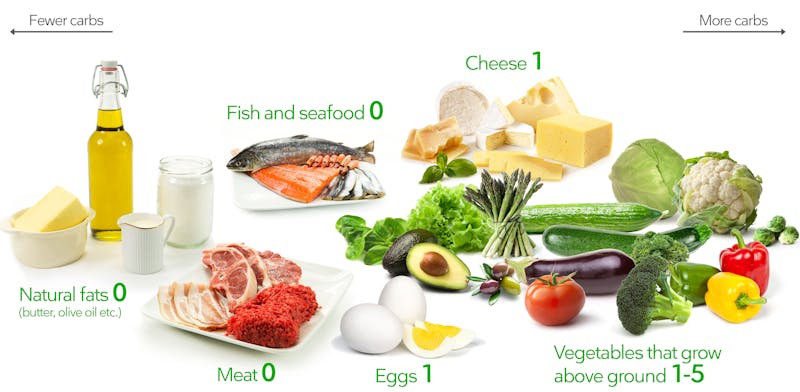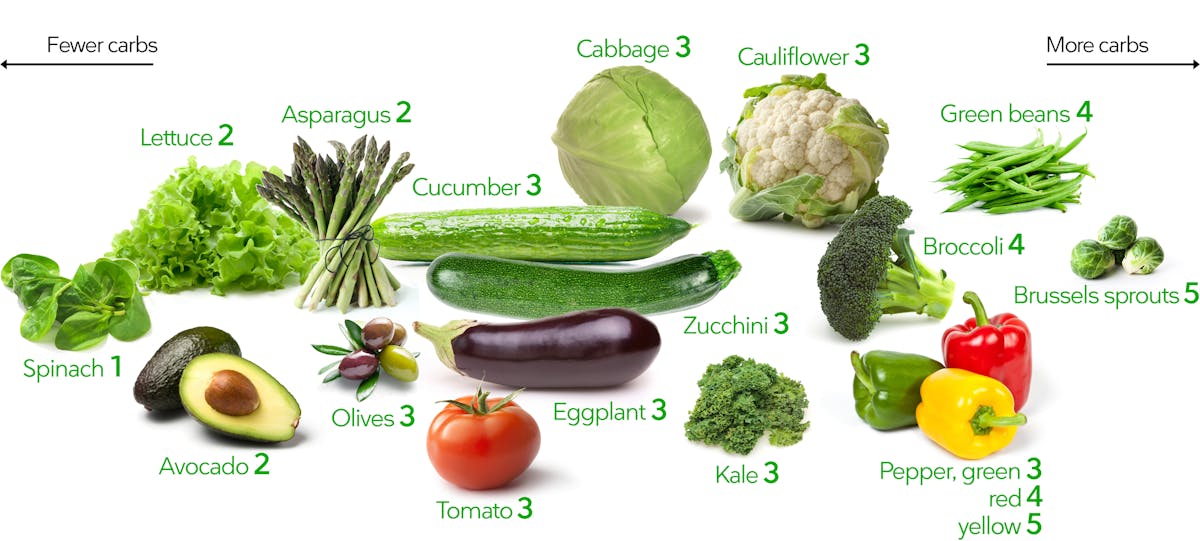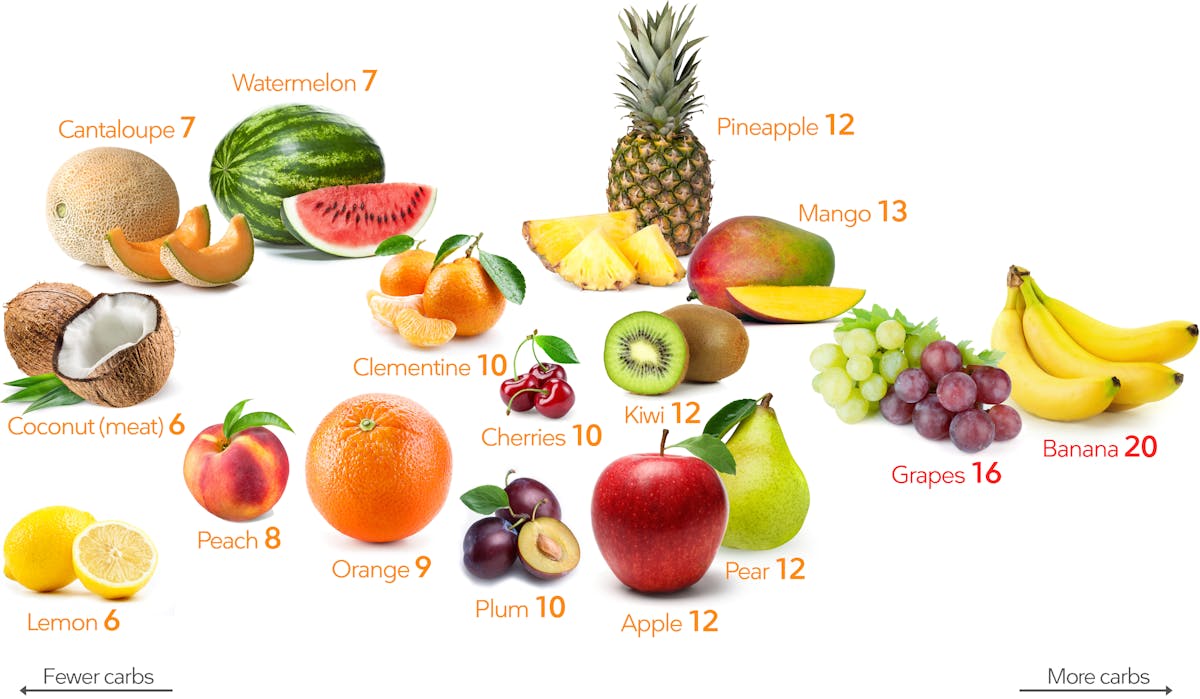A ketogenic diet for beginners

A keto or ketogenic diet is a very low-carb diet, which can help you burn fat more effectively. Many people have already experienced its many proven benefits for weight loss, health and performance.
It’s also used and recommended by many doctors.
Here you’ll learn how to eat a keto diet based on real foods. Below you’ll find visual guides, recipes, meal plans and a simple 2-week get started program, all you need to succeed on keto.
For an audio version of this guide, click the blue icon below:
1. Intro: What is the keto diet?
We make it simple to understand a keto diet and do it right, using our video course above.
Click Here to TRY. , and just keep reading below.
What “keto” means
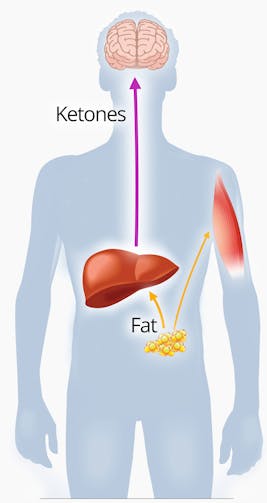
The “keto” in a ketogenic diet comes from the fact that it allows the body to produce small fuel molecules called “ketones”.
This is an alternative fuel source for the body, used when blood sugar (glucose) is in short supply.
Ketones are produced if you eat very few carbs (that are quickly broken down into blood sugar) and only moderate amounts of protein (excess protein can also be converted to blood sugar).
The liver produces ketones from fat. These ketones then serve as a fuel source throughout the body, especially for the brain.
The brain is a hungry organ that consumes lots of energy every day, and it can’t run on fat directly. It can only run on glucose… or ketones.
On a ketogenic diet, your entire body switches its fuel supply to run mostly on fat, burning fat 24-7. When insulin levels become very low, fat burning can increase dramatically. It becomes easier to access your fat stores to burn them off.
This is great if you’re trying to lose weight, but there are also other less obvious benefits, such as less hunger and a steady supply of energy. This may help keep you alert and focused.
When the body produces ketones, it enters a metabolic state called ketosis. The fastest way to get there is by fasting – not eating anything – but nobody can fast forever.
A keto diet, on the other hand, can be eaten indefinitely and also results in ketosis. It has many of the benefits of fasting – including weight loss – without having to fast.
Who should NOT do a ketogenic diet?
There are controversies and myths about a keto diet, but for most people it appears to be very safe.
There are, however, three groups that often require special consideration:
- Do you take medication for diabetes, e.g. insulin? More
- Do you take medication for high blood pressure? More
- Do you breastfeed? More
Are you a doctor or do you need your doctor to help you with medications on a keto diet? Have a look at our low carb for doctors guide.
Disclaimer: While the ketogenic diet has many proven benefits, it’s still controversial. The main potential danger regards medications, e.g. for diabetes, where doses may need to be adapted (see above). Discuss any changes in medication and relevant lifestyle changes with your doctor. Full disclaimer
This guide is written for adults with health issues, including obesity, that could benefit from a ketogenic diet.
Controversial topics related to a keto diet, and our take on them, include saturated fats, cholesterol, whole grains, red meat, whether the brain needs carbohydrates and restricting calories for weight loss.
2. What to eat on a keto diet
Here are typical foods to enjoy on a ketogenic diet. The numbers are net carbs, i.e. digestible carbs, per 100 grams.
To remain in ketosis, lower is generally better:
The most important thing for reaching ketosis is to avoid eating too many carbs. You’ll probably need to keep carb intake under 50 grams per day of net carbs, ideally below 20 grams. The fewer carbs, the more effective it appears to be for reaching ketosis, losing weight or reversing type 2 diabetes.
Counting carbs can be helpful at first. But if you stick to our recommended foods and recipesyou can stay keto even without counting.
Try to avoid
Here’s what you should avoid on a keto diet – carb foods containing a lot of sugar and starch. This includes starchy foods like bread, pasta, rice and potatoes. These foods are very high in carbs.
The numbers are grams of net carbs per 100 grams, unless otherwise noted.
This means that on a keto diet you’ll basically need to avoid sugary foods completely, as well as starchy foods like bread, pasta, rice and potatoes. Also avoid processed foods, and instead follow our keto diet advice.
Furthermore, the food should primarily be high in fat, and only moderately high in protein, as excess protein can be converted to blood sugar in the body. Avoid low-fat diet products. A rough guideline is about 5% energy from carbohydrates (the fewer carbs, the more effective), 15-25% from protein, and around 75% from fat.
What to drink
So what do you drink on a ketogenic diet? Water is the perfect drink, and coffee or tea are fine too. Ideally, use no sweeteners, especially not sugar.
A small amount of milk or cream in your coffee or tea is OK (but beware of caffe latte!). The occasional glass of wine is fine too.
For more, have a look at our full guides to keto drinks and keto alcohol.
Visual keto diet guides
What vegetables are best on a keto diet? There’s a simple rule:
- Above ground vegetables are generally lower carb and therefore the best keto options.
- Below ground vegetables, a.k.a. root vegetables, contain more carbs and should be consumed with care, especially potatoes and sweet potatoes.
Above ground
Carb counts are provided as net carbs per 100 grams (3½ ounces) serving.
Below ground
Carb counts represent net carbs for a standard serving size of 100 grams for each vegetable (3½ ounces, about the weight of an average tomato).
For example, 100 grams of asparagus contain 2 net carbs while 100 grams of broccoli contain 4 net carbs.
It is hard to over-eat spinach, zucchini, lettuce, asparagus and kale on a keto diet. These can be considered keto vegetables.
Note that while the below ground vegetables range from 7 to 17 carbs per 100 grams, the above ground carbs pictures are all under 5 carbs per 100 gram serving. Quite a difference!
A word about onions: while they grow below ground, and are higher carb, onions as a seasoning can be added to foods because generally people do not eat too many onions at once. Be careful of caramelized onions, or sautéed onions, as these are easier to consume in larger amounts. Green onions, or scallions, as a topping for salads and dishes are fine in modest amounts.
Vegetables on keto
All foods are comprised of macronutrients – carbs, protein, and fat. While meat and most dairy are primarily made up of protein or fat, vegetables contain primarily carbs. On a strict ketogenic diet, with fewer than 5% of calories from carbs, it’s important to know which veggies are the lowest in carbs, particularly if your goal is to consume fewer than 20 grams of carbs per day.
On a keto diet, vegetables with less than 5 net carbs may be eaten relatively freely — have them with butter and other sauces!
You will have to be a bit more careful with slightly higher carb vegetables like bell peppers (especially red and yellow ones), Brussels sprouts, and green beans to keep below 20 grams of carbs a day on a keto diet. Their carbs can add up. One medium sized pepper can have 4-7 grams of carbs.
While tomatoes are technically a fruit, you can have them on a keto diet, but again be careful as their carbs are a bit higher and, combined with other foods, may take you up over 20 grams net carbs a day if you consume too much.
If you are doing a more moderate or liberal low-carb diet, with more than 20 grams of carbs a day, you can eat as many above ground vegetables as you desire.
Other helpful guidelines
Here are two more general rules that can help you choose lower-carb and keto vegetables:
- In general, keto friendly veggies are those with leaves — all types of lettuces, spinaches, etc. are good ketogenic options.
- Green vegetables tend to be lower in carbs than veggies with a lot of color. For example, green cabbage is lower in carbs than purple cabbage. Green bell peppers are also somewhat lower in carbs than red or yellow peppers.
Medication with warfarin and vegetable intake: Warfarin (Coumadin, Jantoven) is a medication that is sometimes used to treat or prevent blood clots, and it can be affected by changes in your vegetable intake.
Vegetables and fat
You can use keto vegetables as a vehicle for fat by seasoning cooked vegetables with butter. Better yet, sauté or roast them in lard, coconut oil, avocado oil, or ghee. If you eat dairy, you can make a cream sauce with heavy cream, cheese, and/or cream cheese.
Another excellent way to add fat to vegetables is by dipping them in salad dressings or other dipping sauces, or simply adding olive oil to your salad.
Note that if you have plenty of excess weight that you want to lose, you may not want to overdo the addition of fat. You may want to let your body burn excess body fat, instead of extra added dietary fat. In this case, just eat enough fat to not feel hungry
Top 10 keto vegetables

Here are ten fantastic keto vegetables, tasty and containing plenty of nutrients but very few carbs.
We’ve attempted to rank them in order of popularity and usefulness in keto cooking.
Carb counts are provided as net carbs per 100 gram (3½ ounce) serving.
- Cauliflower – 3 g. The darling of many keto recipes, cauliflower has a mild flavor and is very versatile. It’s used as the base of staples such as cauliflower rice and cauliflower mash. Have a look at our top 18 cauliflower recipes
- Cabbage – 3 g. The humble cabbage becomes a standout when sautéed in butter or used as the base of our popular Asian cabbage stir fry. See more of our top cabbage recipes
- Avocado – 2 g. Technically a fruit, but let’s not get fussy when it is chock full of nutrients, healthy fat, and delicious to boot!Whether eaten plain in slices, mashed as guacamole, or even baked, avocado is a keto go-to, with so many ways to be enjoyed. Here’s some great avocado recipes
- Broccoli – 4 g. A versatile, tasty, and simple replacement for pasta, rice or potatoes. It can be steamed, fried in butter, drizzled in cheese sauce, baked au gratin, roasted with bacon… with so many ways to prepare it you’ll be saying ‘more trees, please!’.
- Zucchini – 3 g. Missing potatoes? Try our zucchini fries or zucchini chips. Zucchini can also be spiralized to make keto pasta, like in this keto carbonara.
- Spinach – 1 g. Extremely low-carb, spinach is one of the most keto-friendly vegetables. It can be used raw in salads, baked into chips, sautéed, or creamed.
- Asparagus – 2 g. Very filling, highly nutritious, and very low carb, asparagus was made for a high-fat sauce such as hollandaise or béarnaise. It’s a great keto vegetable.
- Kale – 3 g. Although slightly higher carb than spinach, use kale raw in salads or bake into chips, sauté in lard, or use as a base instead of pasta. Recipes
- Green beans – 4 g. Green beans can be roasted, steamed, or stewed, but may taste even better cooked in some type of fat such as bacon fat or butter. Recipes
- Brussels sprouts – 5 g. These baby cabbages pack a lot of flavor and are excellent roasted until crispy or served in a creamy sauce. Recipes
Keto crudités
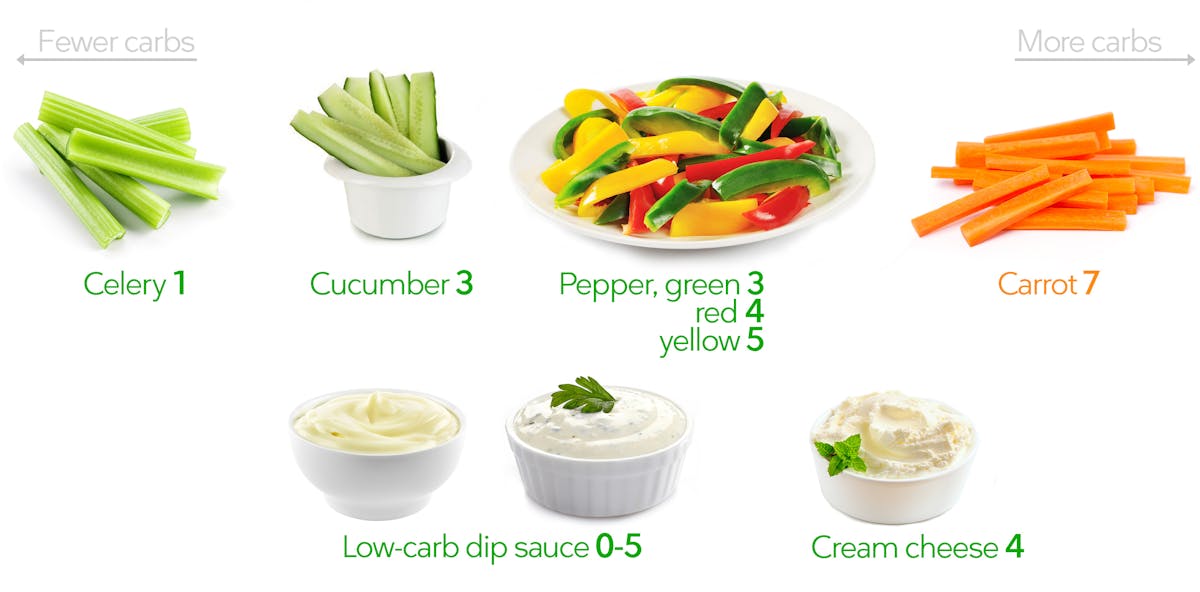
Numbers are digestible carbs per 100 grams (3½ ounces).
Veggie sticks, or crudités, with a high-fat dipping sauce are good keto choices for snacks and before dinner appetizers. Be careful, however, with carrots as their carbs do add up.
Dip: Dipping keto vegetables in a savoury dip, cream cheese, or herbed sour cream is a great way to eat higher fat, should you want to.
Fruits
As you can see, other kinds of fruit are fairly high in carbs, making it very challenging to eat them and stay on a keto diet. Again, each number represents the percentage of net carbs in 100 grams (3.5 ounces) of each fruit. One medium size orange is about 12 grams of carbs.
You might even be able to eat a few cherries or a small plum. Be careful, however, and if in doubt you may want to measure your ketones to assess how fruit impacts you.
Don’t we need fruits’ nutrients? No, you can get those nutrients from vegetables.
In fact, some vegetables, including bell peppers and kale, have more vitamin C than any of the citrus fruits — and a lot less carbs and sugar.

If you eat a large apple (about 25 grams of carbs) or a medium-sized banana (24 grams of carbs) you will have exceeded your daily carb limit on a keto diet.
Fruit = Nature’s candy
On a keto diet you can have some berries every-so-often and it won’t likely take you out of ketosis.
Don’t we need fruits’ nutrients? No, you can get those nutrients from vegetables.
Top 5 fruits to choose

From time-to-time you may be able indulge in a modest amount of fruit as a treat, while still staying in ketosis. Try them with a dollop of unsweetened whipped cream.
Here are some of the best choices, in net carbs:
- Raspberries: Half a cup (60 grams) contains 3 grams of carbs.
- Blackberries: Half a cup (70 grams) contains 4 grams of carbs.
- Strawberries: Eight medium-sized (100 grams) contains 6 grams of carbs.
- Plum: One medium-sized (65 grams) contains 7 grams of carbs.
- Blueberries: Half a cup (75 grams) contains 9 grams of carbs.
Fruit treats
In a pinch, fruit is still a much better choice than many other snacks or treats, like a muffin or candy.
Even though other fruits are higher in carbs, you can indulge every-so-often. Treat it like candy and eat small portions. Here are examples of the carb amounts of other fruit.
- Kiwi: One medium size (70 grams), contains 8 grams of carbs.
- Cherries: Half a cup (75 grams) contains 8 grams of carbs.
- Clementine: One medium size (75 grams) contains 9 grams of carbs.
- Cantaloupe: One cup (160 grams) contains 11 grams of carbs.
- Peach: One medium size (150 grams) contains 13 grams of carbs.
courtesy of dietdoctor.com

